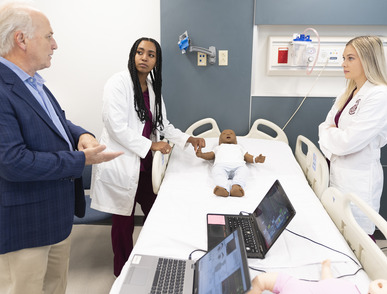
A platform that encourages healthy conversation, spiritual support, growth and fellowship

NOLACatholic Parenting Podcast
A natural progression of our weekly column in the Clarion Herald and blog

The best in Catholic news and inspiration - wherever you are!
Loyola’s $1.9M nursing simulation lab provides practice
-

By Peter Finney Jr.
Clarion Herald
So, how exactly does a nursing student first learn the best way to start an IV or insert a catheter?In the old days, a patient with lots of faith and perhaps a high tolerance for pain served as a willing participant in the student’s quest for knowledge and practical skills.
Thanks to a new $1.9 million nursing simulation lab in Monroe Hall, nursing students at Loyola University New Orleans won’t have to ask if what they are doing hurts because their first “patients” will be high-tech mannequins, who can, in a sense, talk back, but whose feelings can’t be hurt.
Mannequins provide reaction
With several donations, the Loyola Ochsner Nursing Simulation Lab opened Oct. 1 in a partnership with Ochsner Health. The mannequins in the Sim Lab can simulate medical conditions that will either improve or deteriorate based on the treatment they receive from the students.
“The simulations are things like technical skills – IV starts, urinary catheter insertions, suctioning of tracheostomies, wound care, moving patients in bed, assessing the whole person,” said Dr. Michelle Collins, dean of Loyola’s College of Nursing and Health. “Before we had simulations for learning, medical students, nursing students and any other clinical professional students had to learn on real people. Well, you don’t want to be the first person that a new student nurse sticks with an IV or does any other procedure.
“A simulation allows students to practice things that they have to learn in a simulated, real-world environment, without causing any danger or harm or risk to real patients.”
 The need for trained nurses has never been more acute, said Dr. Leonardo Seoane, chief academic officer of Ochsner Health, who noted that the health care industry projects a shortfall of 2.1 million nurses by 2025.
The need for trained nurses has never been more acute, said Dr. Leonardo Seoane, chief academic officer of Ochsner Health, who noted that the health care industry projects a shortfall of 2.1 million nurses by 2025.“That is a true health crisis,” Seoane said. “We feel the shortage today. We have hospital wards and beds that we can’t open because they don’t have enough nurses. This is really impactful and timely.”
The Sim Lab will be used to educate undergraduate students in Loyola’s and Ochsner’s joint bachelor of science nursing program and Loyola’s new accelerated bachelor of science in nursing (ABSN) program, which will be launched in January 2023.
The ABSN program targets people who are changing careers who have a bachelor’s degree or higher in a field other than nursing. Loyola’s graduate students in various specialties will also use the lab.
Pregnancy scenarios tested
One of the simulations in the lab is a device worn by a “patient actor” that mimics the condition and symptoms of a full-term, pregnant woman.
“(It’s) designed to give students an even more realistic patient experience, including simulating the feeling of contractions,” said Dr. Cherie Burke, director of Loyola’s School of Nursing.
Other conditions that can be practiced involve blood loss, cardiac arrest and stroke.
“It’s an incredible opportunity for our students to practice what they are learning in the classroom in a setting that mimics the real world,” said Dr. Tanuja Singh, provost and senior vice president for academic affairs at Loyola.
Major donations for the lab came from the William Randolph Hearst Foundations, the Selley Foundation, the Edward G. Schlieder Educational Foundation and the Alden and Margaret Laborde Foundation.




